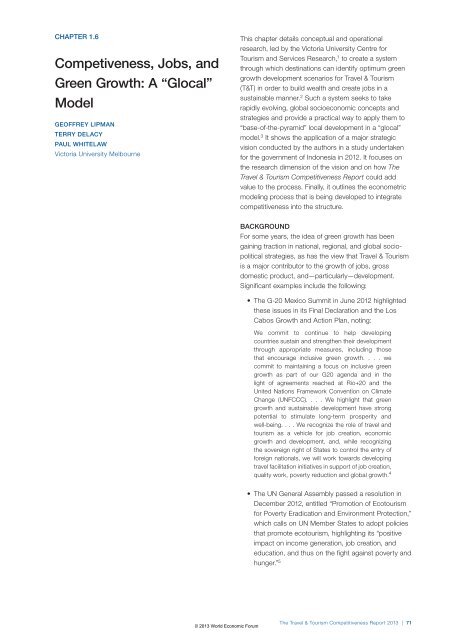The Travel & Tourism Competitiveness Report 2013
The Travel & Tourism Competitiveness Report 2013
The Travel & Tourism Competitiveness Report 2013
You also want an ePaper? Increase the reach of your titles
YUMPU automatically turns print PDFs into web optimized ePapers that Google loves.
CHAPTER 1.6<br />
Competiveness, Jobs, and<br />
Green Growth: A “Glocal”<br />
Model<br />
GEOFFREY LIPMAN<br />
TERRY DELACY<br />
PAUL WHITELAW<br />
Victoria University Melbourne<br />
© <strong>2013</strong> World Economic Forum<br />
This chapter details conceptual and operational<br />
research, led by the Victoria University Centre for<br />
<strong>Tourism</strong> and Services Research, 1 to create a system<br />
through which destinations can identify optimum green<br />
growth development scenarios for <strong>Travel</strong> & <strong>Tourism</strong><br />
(T&T) in order to build wealth and create jobs in a<br />
sustainable manner. 2 Such a system seeks to take<br />
rapidly evolving, global socioeconomic concepts and<br />
strategies and provide a practical way to apply them to<br />
“base-of-the-pyramid” local development in a “glocal”<br />
model. 3 It shows the application of a major strategic<br />
vision conducted by the authors in a study undertaken<br />
for the government of Indonesia in 2012. It focuses on<br />
the research dimension of the vision and on how <strong>The</strong><br />
<strong>Travel</strong> & <strong>Tourism</strong> <strong>Competitiveness</strong> <strong>Report</strong> could add<br />
value to the process. Finally, it outlines the econometric<br />
modeling process that is being developed to integrate<br />
competitiveness into the structure.<br />
BACKGROUND<br />
For some years, the idea of green growth has been<br />
gaining traction in national, regional, and global sociopolitical<br />
strategies, as has the view that <strong>Travel</strong> & <strong>Tourism</strong><br />
is a major contributor to the growth of jobs, gross<br />
domestic product, and—particularly—development.<br />
Significant examples include the following:<br />
• <strong>The</strong> G-20 Mexico Summit in June 2012 highlighted<br />
these issues in its Final Declaration and the Los<br />
Cabos Growth and Action Plan, noting:<br />
We commit to continue to help developing<br />
countries sustain and strengthen their development<br />
through appropriate measures, including those<br />
that encourage inclusive green growth. . . . we<br />
commit to maintaining a focus on inclusive green<br />
growth as part of our G20 agenda and in the<br />
light of agreements reached at Rio+20 and the<br />
United Nations Framework Convention on Climate<br />
Change (UNFCCC). . . . We highlight that green<br />
growth and sustainable development have strong<br />
potential to stimulate long-term prosperity and<br />
well-being. . . . We recognize the role of travel and<br />
tourism as a vehicle for job creation, economic<br />
growth and development, and, while recognizing<br />
the sovereign right of States to control the entry of<br />
foreign nationals, we will work towards developing<br />
travel facilitation initiatives in support of job creation,<br />
quality work, poverty reduction and global growth. 4<br />
• <strong>The</strong> UN General Assembly passed a resolution in<br />
December 2012, entitled “Promotion of Ecotourism<br />
for Poverty Eradication and Environment Protection,”<br />
which calls on UN Member States to adopt policies<br />
that promote ecotourism, highlighting its “positive<br />
impact on income generation, job creation, and<br />
education, and thus on the fight against poverty and<br />
hunger.” 5<br />
<strong>The</strong> <strong>Travel</strong> & <strong>Tourism</strong> <strong>Competitiveness</strong> <strong>Report</strong> <strong>2013</strong> | 71

















